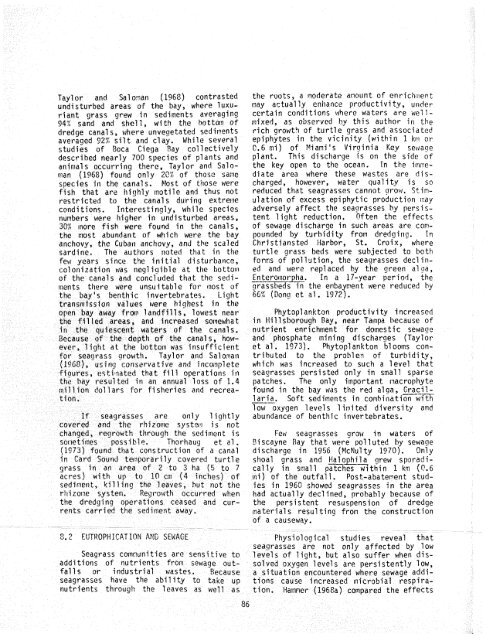The Ecology of the Seagrasses of South Florida - USGS National ...
The Ecology of the Seagrasses of South Florida - USGS National ...
The Ecology of the Seagrasses of South Florida - USGS National ...
You also want an ePaper? Increase the reach of your titles
YUMPU automatically turns print PDFs into web optimized ePapers that Google loves.
Taylor and Sa1 oqan (1968) contrasted <strong>the</strong> roots, a moderate arloifnt <strong>of</strong> enrich!i:e~t.<br />
uodjsturbed areas <strong>of</strong> <strong>the</strong> bay, where iuxu- nay actuatly enhance productivity, urrder<br />
rfant grass grew in sedialentr; averaging certain conditions where ~aters are wcl l-<br />
94% sand and lit~cll, with <strong>the</strong> kott~itl <strong>of</strong> mixed, as observed I?y this author in tbe<br />
dredge canals, where unvegetated sedirvents rich growt? <strong>of</strong> turtle grass and associated<br />
averaged 32% silt and clay. Hhile several epiphytes in <strong>the</strong> vicinity (within 1 krrl or<br />
studies <strong>of</strong> Boca Ciegai Ray collectively<br />
described nearly 700 species <strong>of</strong> plants and<br />
(1.6 mi)<br />
plant.<br />
<strong>of</strong> Pdiaami's Vir~inia Key swage<br />
This discharge is on <strong>the</strong> side <strong>of</strong><br />
animals occurring <strong>the</strong>re, Taylor and Saloman<br />
(1968) falrnd only 2CZ <strong>of</strong> those same<br />
<strong>the</strong> key open to <strong>the</strong> ocean. In tbe in~ediate<br />
area where <strong>the</strong>se wdstes are disspecies<br />
in <strong>the</strong> canals.. FIost <strong>of</strong> those were<br />
ffsh that are highly motil~ and thus not<br />
charged, however, water qua1 ity is so<br />
reduced that seagrasses cannot grow. Stinrestricted<br />
to <strong>the</strong> canal s durirlg extreri~c ul ation <strong>of</strong> excess epiphytic production iy!ay<br />
conditions. Tntcrestingly, whi le species adversely affect <strong>the</strong> seagrasses by persi s-<br />
numbers were higher in undfsturbed areas, tent light reduction, Qften <strong>the</strong> effects<br />
30% ilrore fish were found in <strong>the</strong> canals, <strong>of</strong> sewage discharge in such areas are corn<strong>the</strong><br />
most abundant <strong>of</strong> which wer-e <strong>the</strong> bay pounded by turbidity from dredging. In<br />
itnckovy, thc Cubart anchovy, and <strong>the</strong> scaled Christiansttld Harbor, St, Croix, where<br />
sardine, <strong>The</strong> authors noted that in <strong>the</strong> turtle grass beds were subjected to both<br />
fey4 ycars since <strong>the</strong> in1 tial disturbance, foralis <strong>of</strong> pollution, <strong>the</strong> seaarasses decl incnlnnizatican<br />
was rtegll'gihle at tire botturn ed and were replaced by <strong>the</strong> green aloa,<br />
<strong>of</strong> thc: canals and concluded that thc sedi- acerornor_pf&. In a 17-year period, <strong>the</strong><br />
rnents <strong>the</strong>re were unsul'tiable For most <strong>of</strong> grasms in <strong>the</strong> crrlha ment were reduced by<br />
<strong>the</strong> bayg$ benthic invertebrates. Light 662 (Don:! et a1 . 19723.<br />
tranrfl~fssian values were highest in <strong>the</strong><br />
open bay away froctx landfills, lowest near Phytoplankton productivity increased<br />
<strong>the</strong> fir led areas, and increasctd somewhat in i-lillsborough Bay, near Tarnpa hecause <strong>of</strong><br />
4rs <strong>the</strong> quie~eettt waters <strong>of</strong> <strong>the</strong> canals, nutrient enrichment for domestic sewaae<br />
Because <strong>of</strong> <strong>the</strong> doytt~ <strong>of</strong> <strong>the</strong> canals, how- and phosphate mining discharges (Taylor<br />
ever, 1 ight dt <strong>the</strong> battoirr gas insufffcient et al. 1973). Phytoplankton blooms con-<br />
Par seagrass grawttt, Taylor and Salemarl trihuted to <strong>the</strong> prohle~ <strong>of</strong> turbidity,<br />
{f9C@), using canservlatiue and incomplete whlch was increased to such a level that<br />
figures, astilitated that fi 1 'I operations in scagrasses persisted only in small sparse<br />
<strong>the</strong> bny resul tetl in an annual lass <strong>of</strong> 1.4 patches. <strong>The</strong> only irnportant nacrophyte<br />
mfl'l ion r!ollars for ff sherles and recrea- found in <strong>the</strong> hay wds <strong>the</strong> red alga, Craciltfan.<br />
- laria, S<strong>of</strong>t sediments in combinalti~~?~<br />
low oxygen levels 1 iirrited diversity and<br />
IP seagrasses are only 1 igt\tly abundance <strong>of</strong> benthic invertebrates,<br />
covered and <strong>the</strong> rhizotire systalr is not<br />
changed, regrowtt.~ through <strong>the</strong> scditnent is Few seagrasses grow in waters <strong>of</strong><br />
stltretfmes possltslc?, Thorhatrg et a1. Dl'scayne Ray that were pol luted hy sewage<br />
(1973) found tht c<strong>of</strong>lstructian <strong>of</strong> a canal discharge in 1956 (McNul ty 1470). Only<br />
In Card Sound tetnporarily ceverod turtle shoal grass and Halophilal grew sporadi-<br />
Z km (Q.6<br />
gras5 Jn nn area <strong>of</strong> 2 ta 3 ha (5 to 7 cally in small patches w~thin<br />
acres) w-i th up to 10 cm (4 inches) <strong>of</strong> ini) <strong>of</strong> <strong>the</strong> outfall. Post-abaterent studsedirqerrt,<br />
killfrzg <strong>the</strong> leaves, hut not: thc ies Jn 1960 sfro~ed seagrasses in <strong>the</strong> area<br />
ri1iz01"r system, Regt-owth occurred when had actual ly decl ined, probably because <strong>of</strong><br />
<strong>the</strong> drcdglng operations ceased and cur- <strong>the</strong> persistent resuspension <strong>of</strong> dredge<br />
rents carriePl <strong>the</strong> sedlnlent away,<br />
materials resulting fron <strong>the</strong> construction<br />
<strong>of</strong> a causeway.<br />
6,2 EUTKQPH ICAJ ION AEC SEgAGE Physiological studies reveal that<br />
seagrasses are not only affected by low<br />
S~agrass ~0wif"~ltnities arc sensitive to levels <strong>of</strong> light, but also suffer %!hen disadd1<br />
tions <strong>of</strong> ntatrients from sewage out- solved oxygen levels are persistently low,<br />
falls or industrial wastes. Because a situation encountered where sewage addiseagsasscs<br />
have <strong>the</strong> ability to take up tions cause increased microbial respiranutrfents<br />
throtrgh thc leaves as well as tion, Hammer (1968a) compared <strong>the</strong> effects<br />
86

















